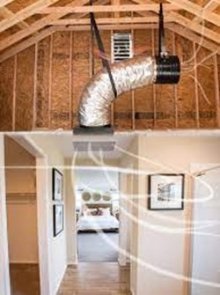Cooling using a whole house fan can substitute for an air conditioner in some climates. Whole house fans combined with ceiling fans and other circulating fans provide acceptable summer comfort for many families.
How Whole House Fans Work
The whole house fan pulls air in from open windows and exhausts it through the attic and roof. It provides good attic ventilation in addition to whole house cooling. Whole house fans should provide houses with 15 to 23 air changes per hour (varies with climate, floor plan, etc.—check with a professional to determine what is appropriate for your home). The air-change rate you choose depends on your climate and how much you will depend on the whole house fan for cooling.
Installing and Using a Whole House Fan
Installing a whole house fan is tricky and should be done by a professional. An experienced professional should take your attic measurements and install your dedicated circuit wiring and, if needed, your new attic vents.
Attic ventilation will usually need to be increased to exhaust the fan’s air outdoors. You’ll need 2 to 4 times the normal area of attic vents, or about one square foot of net free area for every 750 cubic feet per minute of fan capacity. The net free area of a vent takes into account the resistance offered by its louvers and insect screens. More vent area is better for optimal performance.
If your fan doesn’t come with a tight-sealing winter cover, you should either buy one or build one. If you switch between air conditioning and cooling with a whole house fan as the summer weather changes, build a tightly sealed, hinged door for the fan opening that is easy to open and close when switching cooling methods.
Be cautious when operating these large exhaust fans. Open windows throughout the house to prevent a powerful and concentrated suction in one location. If enough ventilation isn’t provided, the fans can cause a backdraft in your furnace, water heater or gas-fired dryer, pulling combustion products such as carbon monoxide into your living space.
Drawbacks
Whole house fans can be noisy, especially if improperly installed. In general, a large-capacity fan running at low speed makes less noise than a small fan operating at high speed. All whole house fans should be installed with rubber or felt gaskets to dampen noise. You can set a multi-speed fan to a lower speed when noise is a problem.
Call us today! 832-661-6154



Recent Comments